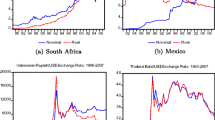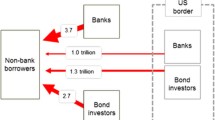Abstract
At the outset of the Great Recession emerging in 2007, central banks of major-currency economies have adopted non-standard monetary policies. We examine whether and to what extent these measures pose a challenge to central banking in emerging and small open economies. In particular we assess how global liquidity spillovers caused by major central banks affect the economic dynamics of emerging and small open economies. In this respect, economies which are close to or even at the periphery of major-currency economies are particularly prone to “unbalanced” real exchange rate dynamics. In the short run, corresponding level and volatility effects in key relative prices may endanger financial stability in the recipient country. The long-term effects include a metamorphosis of the anchoring of private-sector inflation expectations into a perilous tightrope act in central banking of these economies.



Similar content being viewed by others
Notes
The Polity IV Annual Time-Series contains information on regime and authority characteristics of all independent states with a total population of 500,000 or more and covering the years 1800–2015. The dataset is available here: http://www.systemicpeace.org/inscrdata.html.
References
Akinci O, Olmstead-Rumsey J (2017) How Effective Are Macroprudential Policies? An Empirical Investigation. J Financ Intermed. https://doi.org/10.1016/j.jfi.2017.04.001
Amiti M, Weinstein DE (2011) Exports and Financial Shocks. Q J Econ 126:1841–1877
Balassa B (1964) The Purchasing Power Parity Doctrine: A Reappraisal. J Polit Econ 72(6):584–596
Bauer MD, Neely CJ (2014) International Channels of the Fed’s Unconventional Monetary Policy. J Int Money Financ 44:24–46
Belke, A (2013) Exit Strategies and Their Impact on the Euro Area – A Model Based View, Briefing paper prepared for presentation at the Committee on Economic and Monetary Affairs of the European Parliament for the quarterly dialogue with the President of the European Central Bank, December, Brussels
Belke A, Schnabl G (2015) Exchange Rate Challenges in Emerging Markets and Developing Countries. Rev Dev Econ 19(3):449–454
Belke A, Setzer R (2004) The Real Impacts of Excessive Exchange Rate Volatility in Emerging Markets. In: Frenkel M, Karmann A, Scholtens B (eds) Sovereign Risk and Financial Crises. Springer, Heidelberg, pp 191–201
Belke A, Verheyen F (2014) The Low Interest Rate Environment, Global Liquidity Spillovers and Challenges for Monetary Policy Ahead. Comp Econ Stud 56:313–334
Belke A, Orth W, Setzer R (2010) Liquidity and the Dynamic Pattern of Asset Price Adjustment: A Global View. J Bank Financ 34:1933–1945
Belke, A, Dubova I, Volz U (2017a) Bond Yield Spillovers from Major Advanced Economies to Emerging Asia. Pacific Economic Review. http://eprints.soas.ac.uk/id/eprint/24098
Belke A, Gros D, Osowski T (2017b) The Effectiveness of the Fed’s Quantitative Easing Policy: New Evidence Based on Interest Rate Differentials. J Int Money Financ 73:335–349
Belke A, Haskamp U, Schnabl G (2017c) Beyond Balassa and Samuelson: Real Convergence, Capital Flows, and Competitiveness in Greece. Empirica. https://doi.org/10.1007/s10663-017-9366-6
Benigno G, Chen H, Otro C, Rebucci A, Young ER (2012) Financial Crises and Macro-Prudential Policies. J Int Econ 89(2):453–470
Bowman D, Londono JM, Sapriza H (2015) U.S. Unconventional Monetary Policy and Transmission to Emerging Market Economies. J Int Money Financ 55:27–59
Buch, Claudia M., Sandra Eickmeier, and Esteban Prieto. 2014. In Search for Yield? Survey-based Evidence on Bank Risk Taking. J Econ Dyn Control 43:3, 12–30.
Burger JD, Francis EW, Warnock VC (2017) The Effects of U.S. Monetary Policy on Emerging Market Economies' Sovereign and Corporate Bond Markets, NBER Working Paper 23628, National Bureau of Economic Research, Cambridge
Castillo P, Carrera C, Ortiz M, Vega H (2014) Spillovers, Capital Flows and Prudential Regulation in Small Open Economies. BIS Working Papers Series, No 459
Chinn MD, Ito H (2006) What Matters for Financial Development? Capital Controls, Institutions, and Interactions. J Dev Econ 81(1):163–192
Christiano LJ, Motto R, Rostagno M (2014) Risk Shocks. Am Econ Rev 104(1):27–65
Corden WM (1984) Booming Sector and Dutch Disease Economics: Survey and Consolidation. Oxf Econ Pap 36(3):359–380
Corden WM, Peter Neary J (1982) Booming Sector and De-Industrialization in a Small Open Economy. Econ J 92(368):825–848
D’Amico S, King TB (2013) Flow and Stock Effects of Large-Scale Asset Purchases: Evidence on the Importance of Local Supply. J Financ Econ 108(2):425–448
Gabrisch H, Staehr K (2015) The Euro Plus Pact: Competitiveness and External Capital Flows in the EU Countries. J Common Mark Stud 53(3):558–576
Horvath R (2017) International Spillovers of ECB’s Unconventional Monetary Policy: The Effect on Central Europe. Appl Econ 49:2352–2364
International Monetary Fund (2013) Global Impact and Challenges of Unconventional Monetary Policies. IMF Background Paper, Washington/DC
Jeanne, O. (2014) Macroprudential Policies in a Global Perspective. NBER Working Paper 19967, National Bureau of Economic Research, Cambridge
Kaldor N (1981) The Role of Increasing Returns, Technical Progress and Cumulative Causation in the Theory of International Trade. Econ Appl 34(4):593–617
Keynes JM (1929) The German Transfer Problem. Econ J 39(153):1–7
Lavigne R, Sarker S, Vasishtha G (2014) Spillover Effects of Quantitative Easing on Emerging-Market Economies. Bank of Canada Review 2014:23–33
Malik S (2015) Financial-Integration Thresholds for Consumption Risk-Sharing. Int Rev Econ Financ 38:73–93
Manova K (2013) Credit Constraints, Heterogeneous Firms, and International Trade. Rev Econ Stud 80(2):711–744
McCauley RN, McGuire P, Sushko V (2015) Global Dollar Credit: Links to US Monetary Policy and Leverage. Econ Policy 30(82):187–229
Neely CJ (2015) Unconventional Monetary Policy Had Large International Effects. J Bank Financ 52(3):101–111
Rajan RG, Zingales L (1998) Financial Dependence and Growth. Am Econ Rev 88(3):559–586
Rüffer R, Stracca L (2006) What is Global Excess Liquidity, and Does It Matter? ECB Working Paper Series, No. 696
Samuelson PA (1964) Theoretical Notes on Trade Problems. Rev Econ Stat 46(2):145–154
Yu C (2015) Evaluating International Financial Integration in a Center-Periphery Economy. J Int Econ 95(1):129–144
Author information
Authors and Affiliations
Corresponding author
Ethics declarations
Disclaimer
The paper was written when the corresponding author was a visiting scholar at Eesti Pank, Tallinn, Estonia. The content is solely the responsibility of the authors and does not necessarily represent the official views of the DIHK.
Rights and permissions
About this article
Cite this article
Belke, A., Fahrholz, C. Emerging and small open economies, unconventional monetary policy and exchange rates – a survey. Int Econ Econ Policy 15, 331–352 (2018). https://doi.org/10.1007/s10368-017-0395-1
Published:
Issue Date:
DOI: https://doi.org/10.1007/s10368-017-0395-1




